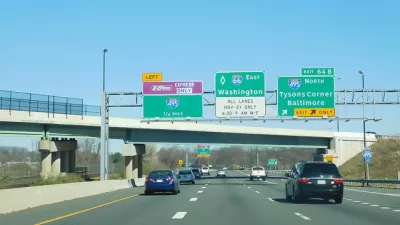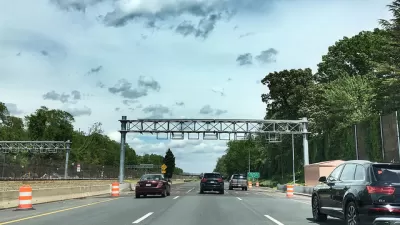Widening of Interstate 66 for 22.5 miles in Northern Virginia will accommodate two toll lanes in each direction, accessible to trucks. The $3.7 billion project, to be built by public-private partnership at no cost to the state, will open in 2022.
"The first major construction work on Interstate 66 toll lanes between the Capital Beltway [I-495] and Gainesville, Virginia, is set to begin as soon as this weekend, kicking off four years of construction lane shifts, closures and delays," reports Max Smith for WTOP News.
The two toll lanes in each direction, similar to the I-495 Express Lanes, are due to open by the end of 2022. Drivers will be able to ride free with a total of three or more people in the car and an E-ZPass Flex in HOV mode; motorcycles and buses will ride free, too. Other cars and trucks will pay a toll that rises and falls based on the amount of traffic in the lanes.
Yes, trucks will have access to the congestion-priced toll lanes, though they "will be required to pay at least three times the toll other drivers are paying at a given time," reported Smith on Dec. 8, 2016. The toll will increase with the level of congestion in order to maintain travel speeds.
That provision allowed the Virginia Department of Transportation (VDOT) and the Virginia Department of Rail and Public Transportation to secure a higher payment for corridor improvements from the largely European consortium, I-66 Express Mobility Partners, consisting of Madrid-based, Cintra, Paris-based Meridiam, Madrid-based Ferrovial and Pennsylvania-based Allan Myers. The unsuccessful bidder was Express Partners, formed by Australian-based Transurban and Stockholm-based Skanska.
Improvements for the corridor included in the project, known formally as Transform 66 Outside the Beltway, include:
- New and improved bus service and transit routes
- New and expanded park and ride lots providing convenient access to the Express Lanes and more than 4,000 new park and ride spaces
- Interchange improvements to enhance safety and reduce congestion, including auxiliary lanes between interchanges, where needed
- 11 miles of new bike and pedestrian trails, including shared-use trails along I-66 that integrate with local trails, and new crossings of I-66 to improve and expand bicycle and pedestrian routes
[For more information on the bike trails, and an alternative suggested by the Fairfax Alliance for Better Bicycling, see Planetizen: "Critiquing the Proposal to Locate a Bike Lane on an Interstate," June 2017.]
I-66 Inside the Beltway
When the new I-66 express lanes outside the Beltway open in 2022, the 66 Express Lanes Inside the Beltway, which currently require only a minimum of two occupants to qualify for free carpool access, will increase to three. Those lanes opened to great notoriety last December due to $40 plus tolls.
On March 29, Smith reported on the performance of the new dynamically-priced lanes.
Only a few drivers — 989, about 0.25 percent of toll payers — paid $40 or more in February for a single trip.
Tolls have reached $46.75 at the busiest times of morning rush hours. The morning rush tolls are higher in part because of the merge at the Dulles Connector Road.
The 10 miles of 66 Express Lanes inside the Beltway were built by VDOT using "self-financing," meaning it is based on expected toll revenue, reported Robert Thomson for The Washington Post on Dec. 9, 2015. A compromise required to overcome political challenges allowed the addition of one new lane, which cost the state $140 million. Initially, the project had been based on the conversion of two High Occupancy Vehicle (HOV or carpool) lanes, one in each direction, to High Occupancy Toll (HOT) lanes.
Hat tip IBTTA Smart Brief.
FULL STORY: 4 years of major I-66 construction to begin as soon as this weekend

Alabama: Trump Terminates Settlements for Black Communities Harmed By Raw Sewage
Trump deemed the landmark civil rights agreement “illegal DEI and environmental justice policy.”

Planetizen Federal Action Tracker
A weekly monitor of how Trump’s orders and actions are impacting planners and planning in America.

The 120 Year Old Tiny Home Villages That Sheltered San Francisco’s Earthquake Refugees
More than a century ago, San Francisco mobilized to house thousands of residents displaced by the 1906 earthquake. Could their strategy offer a model for the present?

In Both Crashes and Crime, Public Transportation is Far Safer than Driving
Contrary to popular assumptions, public transportation has far lower crash and crime rates than automobile travel. For safer communities, improve and encourage transit travel.

Report: Zoning Reforms Should Complement Nashville’s Ambitious Transit Plan
Without reform, restrictive zoning codes will limit the impact of the city’s planned transit expansion and could exclude some of the residents who depend on transit the most.

Judge Orders Release of Frozen IRA, IIJA Funding
The decision is a victory for environmental groups who charged that freezing funds for critical infrastructure and disaster response programs caused “real and irreparable harm” to communities.
Urban Design for Planners 1: Software Tools
This six-course series explores essential urban design concepts using open source software and equips planners with the tools they need to participate fully in the urban design process.
Planning for Universal Design
Learn the tools for implementing Universal Design in planning regulations.
Clanton & Associates, Inc.
Jessamine County Fiscal Court
Institute for Housing and Urban Development Studies (IHS)
City of Grandview
Harvard GSD Executive Education
Toledo-Lucas County Plan Commissions
Salt Lake City
NYU Wagner Graduate School of Public Service





























